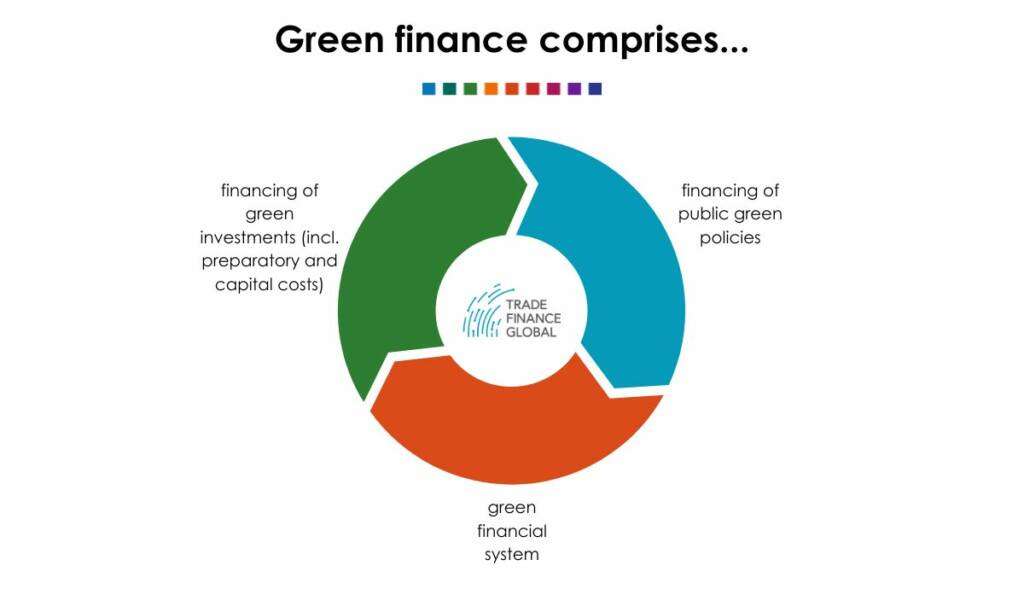“The business of business is business.”
Economist, Milton Friedman
Friedman famously argued that the only purpose of business is to earn a profit, an underlying ideology of the finance industry. He believed that governing bodies hold the sole responsibility for society’s sustainability goals. However, business growth is totally dependent on societal input. After all, societal needs fuel the demand part of supply and demand. So, how can we develop sustainable rewards for green finance?
Although some modern businesses engage in philanthropy, this is often corporate greenwashing. Society needs business leaders to shift away from a capitalist mindset and engage in real sustainability. Green finance is pivotal to allocating capital towards building a sustainable future. It explains why green financing is important in corporate sustainable value creation and how sustainable rewards can complement the implementation of a successful sustainable corporate strategy.

Source: ESG News
What is Green Finance?
The Method
Sustainable finance is a method for integrating sustainability into business strategy. It involves financing a project to generate economic activity, without compromising future generations. It has become clear that the increased rate of natural calamities is linked to increasing business activities. This has created a demand for scrutinising future projects that have negative externalities. For instance, Gunns Limited proposed a $2.3 billion paper mill project in Tasmania, but Australia was unable to attract funding. This was due to serious allegations regarding its long-term environmental sustainability.
Sustainability Practices
Academic research and business experience only prove the need for embedding sustainability practices into business processes and strategies. Recent studies have found that strong sustainability and sustainable rewards positively correlate with better performance and higher equity returns. The International Finance Corporation (IFC) analysed 656 companies in its portfolio in 2018. It found that companies with good environmental and social considerations tend to outperform others by 2.1% in terms of return on equity.
A Profitable Future
A study by Lu et al. (2022) finds a positive relationship that firms with better sustainability performance are more profitable in the future. Further, firms with better financial performance have higher subsequent sustainability performance. The study goes further to suggest that sustainability provides ‘insurance’-like protection against economic downturns during COVID-19.
Today’s businesses are dealing with a slew of complex and quickly evolving social, environmental, economic and technological trends. This has increased the requirement for sustainable practices and risk management. Businesses are still reluctant to invest resources in sustainable strategies under the mistaken belief that the costs outweigh the benefits Whelan & Fink (2016). Executives should be heeding the advice of experts to make the shift towards a more sustainable future before time runs out. The THRIVE Framework is a transdisciplinary approach that allows us to create models that account for the uncertainty, volatility and complexity of these issues we face.

Source: Trade Finance Global
Why is Green Finance important in producing sustainable rewards?
The Harvard Business Review (2016) has provided concrete examples of how sustainability benefits the bottom line.
Driving Competitive Advantage Through Stakeholder Engagement
Businesses can learn a lot by continually engaging with stakeholders. This leaves them in a better position to face any ESG-related issues that may arise. For example, the gold mining industry finds business operations (land use and regulations) being influenced heavily by communities in the area, resulting in conflict. Increased stakeholder engagement improves cooperation.
Reducing Risks
Supply chains around the world are increasingly exposed to climate change, adverse weather events and civil conflict. Increased investment in climate change mitigation and adaptation strategies by organisations can provide buffers for businesses. According to the Food and Agriculture Organization (FAO), the African, Latin American and Asian regions lost over $116 million worth of agricultural production due to flooding between 2008 and 2018.
Fostering Innovation
Investing in sustainability can be achieved through redesigning products to meet environmental and social standards expected in the industry. For example, Nike introduced the Flyknit line which uses advanced yarn manufacturing technology. As a result, it reduced waste by 80 per cent compared to the previous manual process (Innovation in Textiles, 2015). Consequently, this not only supports the environment but also significantly increased Nike’s profit margins.

Source: Innovation in Textiles
Increased Customer Satisfaction and Loyalty
Over the past few years, there has been a shift in consumer behaviour. The change has seen an increased willingness to spend more on sustainable products (Capterra, 2022) (Hainmueller and Hiscox, 2015). According to a 2016 Harvard Business Review report, nearly two-thirds of consumers across six regions believe they have the responsibility to purchase products that are good for the environment and society. Therefore, businesses can increase their revenue by focusing on sustainable products and benefit from higher prices as well.
Attracting and Retaining Talent Within the Organisation
According to Deloitte’s 2017 Millennial Survey, millennials feel responsible and accountable for many issues in the workplace and believe they can make the most impact via the workplace. By being environmentally and socially conscious in their business activities, employers can keep staff motivated and engaged.
Corporate value creation and the Allocation of green funds
Green finance channels capital towards projects and initiatives that have positive environmental impacts. Providing financial resources enables the implementation of sustainable practices, such as renewable energy projects, energy efficiency improvements, sustainable infrastructure, or initiatives to reduce carbon emissions. These initiatives ultimately result in long-term corporate value creation and thrivability.
The decision to allocate capital towards sustainable practices lies with the Board of Directors (Eccles and Youmans, 2015). Shareholders also have a major influence in this regard. As Peattie & Samuel (2018) argue, ethically motivated shareholder support can be considered a challenge. Establishing societal, ideological, and cultural themes that have progressed from the capitalistic paradigm established by Friedman in the 1970s still proves to be a difficult task. In addition to shareholders, the employees of established companies need to be convinced to contribute to the cause. One way that we can overcome this challenge of onboarding stakeholder interest in sustainable investment is through sustainable rewards.

Source: Development Asia
Sustainable rewards more broadly
Sustainable rewards can complement green finance by offering additional incentives, making it more attractive for stakeholders to participate in sustainable projects (Beck-Krala et al., 2018). For example, individuals may be rewarded for reducing their carbon footprint, using public transportation, or engaging in recycling programs. Businesses may receive incentives for implementing energy-efficient technologies, reducing waste, or adopting sustainable supply chain practices. Green finance can support such initiatives by providing funding and resources to implement these sustainable practices.
Motivation to Achieve Sustainable Rewards
A study by Kang et al. (2022) shows that sustainability training and sustainable rewards have a significant impact on the sustainable behaviour of employees. The study goes further to prove that employees are more motivated to engage in sustainable behaviours by monetary rewards than non-monetary rewards. The reason for this may be that with the rise of people’s awareness of sustainability, individuals are also more aware of the importance of a work–life balance. Therefore, the study recommends that enterprises provide travel subsidies/bonuses and/or increase the number of staff vacation days to encourage employees to participate in sustainable activities, such as beach cleaning, volunteering, etc.
Overall Benefits and Sustainable Rewards
Sustainable practices by employees inevitably translate to long-term benefits for the organisation and, in turn, shareholder value. McKinsey Sustainability found that 83 per cent of C-suite leaders and investment professionals felt that environment, social and governance (ESG) programmes would contribute more shareholder value in the next five years. Alternatively, sustainable rewards can also be provided in the form of dividends to shareholders. This will encourage shareholders and investors to divert more funds into sustainable activities.
why should we focus on sustainable rewards and Green Finance?
Green finance provides the financial mechanisms to support sustainable projects, while sustainable rewards incentivise individuals for their sustainable behaviour (Ramus, 2002). As a result, this fosters a transition towards a more sustainable future (Mandago, 2018)
The buy-in of all employees in order to make the transition to a sustainable future is vital. Without the motivation and drive of each individual, cooperation among the team to achieve a unified goal will not transpire. When staff embrace the culture of making a positive change, they pass on the same sentiments to customers. This creates a snowball effect, increasing awareness amongst the public.
Although rewards increase green initiatives in organisations, it also poses the threat of malpractice. Studies show that incentives encourage executives to use accounting and other techniques to achieve short-term results and enrich themselves (Mandago, 2018). It is important that we are able to distinguish between truthful ambitions and greenwashing.
achieving the United Nations Sustainable Development Goals (SDGs) through sustainable rewards
The effectiveness of sustainable rewards and compensation is best observed in a study conducted by Berrone and Gomez-Mejia (2009). The analysis was performed on 469 US firms operating in high-polluting industries. They found that firms with eco-friendly performance paid their CEOs more than non-ecofriendly firms. The study also concluded that long-term employee compensation was associated with greater pollution prevention success.
With the efficacy of green rewards being evidenced, it can be concluded that sustainable incentives support the UN’s Sustainable Development Goals (SDGs). Ultimately, incentives are provided to perform activities that are beneficial to the environment and community, to promote sustainable economic development for SDG 8. With incentives for using public transport to offices and reducing business travel, organisations can reduce their carbon footprint (SDG 13) and encourage inclusive cities (SDG 11). Sustainable incentives (such as paid time off to attend volunteering activities) also contribute to employee well-being and good health (SDG 3).

Source: Pexels
Moving Forward with A Thrivable Framework and Sustainable Rewards
In conclusion, sustainable rewards and green finance can play a significant role in achieving sustainability. Together, sustainable rewards and green finance create a reinforcing cycle. Green finance supports the financing of sustainable projects, while sustainable rewards motivate and incentivise stakeholders to engage in sustainable practices. Accordingly, this combination helps drive the adoption of sustainable solutions, fosters innovation and promotes the integration of environmental considerations into financial decision-making.
Furthermore, we must implement sustainable rewards and green finance to regulate effectively. This helps to avoid greenwashing or unintended negative consequences. Transparency, accountability, and robust standards are necessary to verify the environmental integrity of projects and the credibility of sustainable rewards.
For guidance on ensuring we successfully plan and implement sustainable strategies, visit THRIVE Project and test drive the THRIVE Platform. Organisations and individuals should not simply focus on mitigating techniques. THRIVE Project encourages us to go beyond in thinking about how we can make our communities flourish and bring back an abundance of resources to our planet. THRIVE Framework adopts a systemic holistic model by using scientific data and cultural phenomena to strive to thrive and engineer a sustainable and thrivable future.























